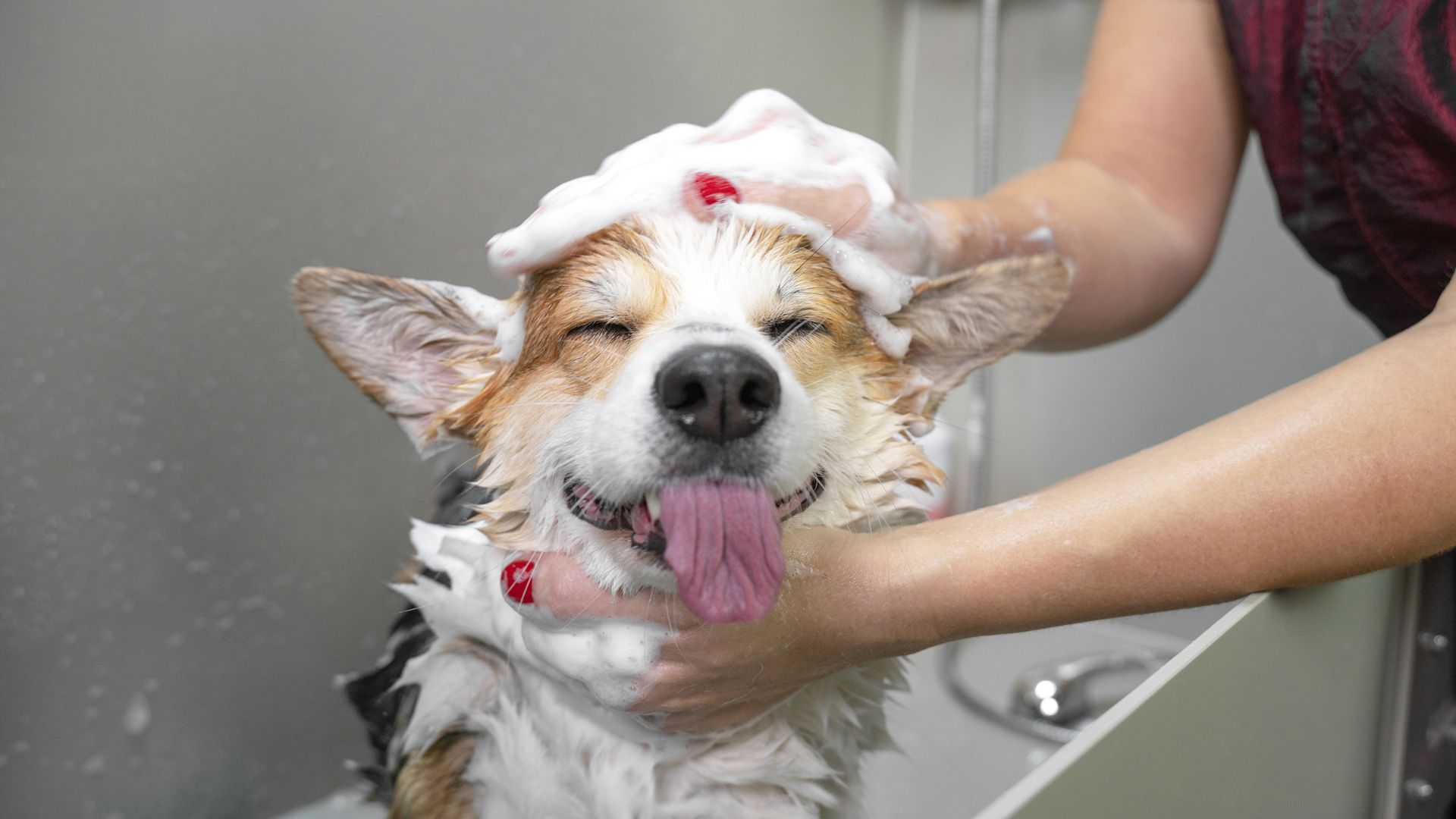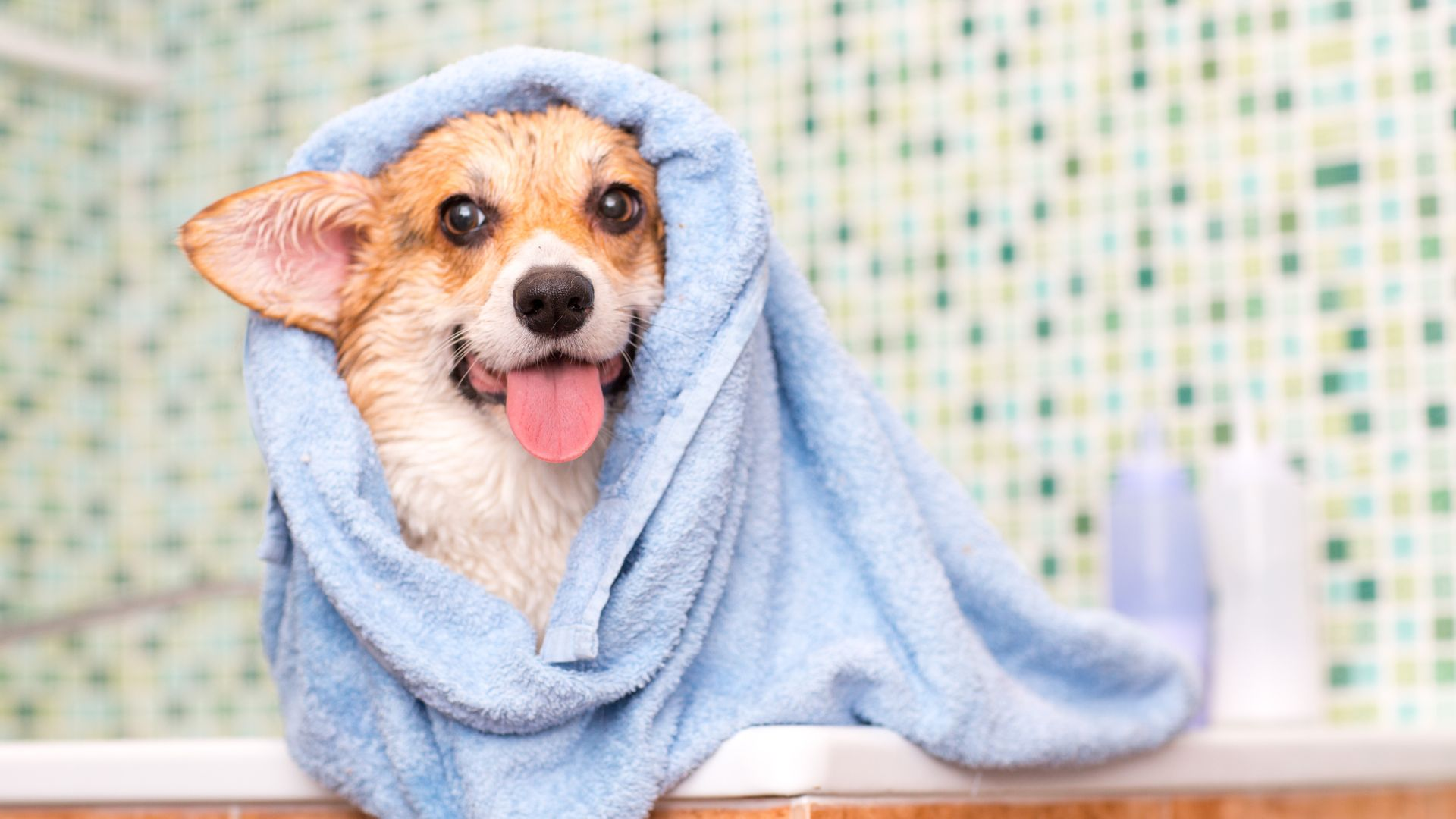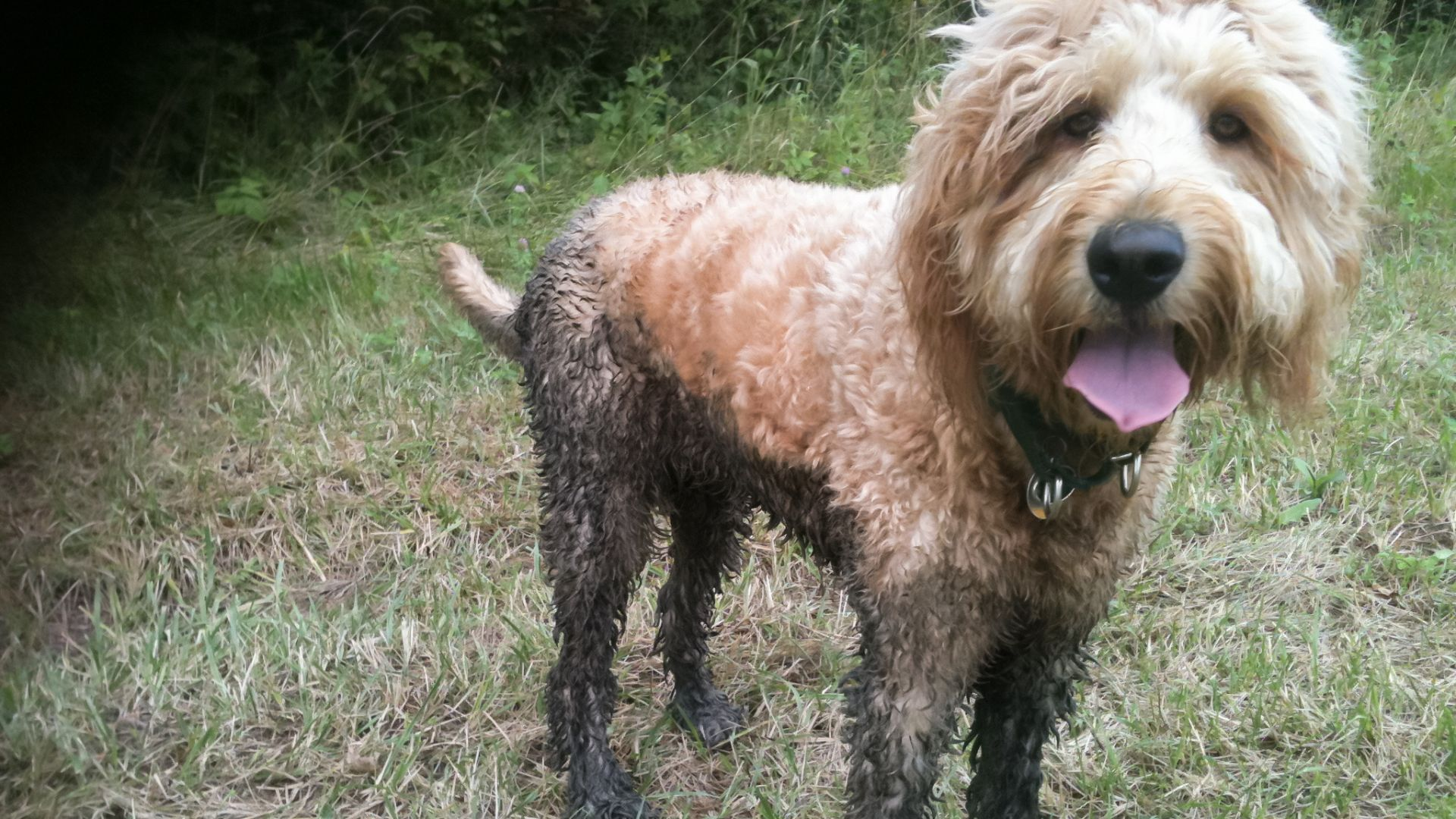When caring for your furry friend, regular bathing is a crucial part of maintaining their hygiene and overall health. Proper grooming keeps your dog looking and smelling fresh. It helps prevent skin infections, parasites, and other health issues from poor hygiene.
Dirt, debris, and bacteria can accumulate on your dog’s coat over time. Without proper cleaning, these substances can lead to skin irritation or infection.
A clean dog is a happy dog—plus they’re much more pleasant to cuddle with! Bathing your dog regularly also helps control odors from a build-up of bacteria or dirt on their skin. At Pet Gifts & Toys, we review how often your dog should be bathed.
Common Misconceptions About Dog Bathing Frequency

One common myth is that you should never bathe your dog because it will strip the natural oils in their coat. However, this is only partially true.
While frequent bathing with harsh shampoos can dry out your dog’s skin and fur, regular bathing with gentle products designed for dogs can improve the condition of their coat. Another misconception is that all dogs must be bathed at the same frequency.
How often you should bathe your pup depends on several factors such as breed type, coat length and texture, activity level, and lifestyle habits like swimming or rolling in dirt. Finding the right balance will ensure you keep your furry friend clean without causing unnecessary stress or damage to their skin or fur.
Factors to Consider When Deciding How Often to Bathe Your Dog
Breed and Coat Type: Does Your Dog Shed a Lot?

One of the first factors you should consider when deciding how often to bathe your dog is their breed and coat type. Certain breeds have coats that require more frequent bathing, while others can go longer without one.
Dogs with long, thick coats, like Huskies or Golden Retrievers, may need more baths because they shed more fur, and dirt can get trapped in their fur. On the other hand, breeds with shorter or single-layered coats, like Boxers or Chihuahuas, may only need a few baths because their fur doesn’t trap dirt as easily.
Additionally, dogs with curly coats, like Poodles or Bichons, will require different grooming methods than those with straight hair. Curly-coated breeds are prone to matting, so regular brushing and combing is essential to prevent tangles.
If your curly-coated dog goes too long between baths, their coat may become matted and hard to manage.
Activity Level and Lifestyle: Does Your Dog Love Playing Outside?

Another factor that influences how often you should bathe your dog is their activity level and lifestyle. If your dog loves playing outside, rolling in the mud, or swimming in ponds or lakes, they will likely need more frequent baths than a dog who spends most of its time indoors. Dogs who spend most of their time inside will get cleaner than those who run all day outside.
It’s important to note that frequent bathing can strip away natural oils from your dog’s skin and coat, which could lead to skin irritation or dryness if overdone. So if you need clarification how often you should bathe your furry friend who loves playing outside, it might be best to consult a veterinarian for frequency guidance.
Skin Conditions and Allergies: Does Your Dog Have Sensitive Skin?
If your dog has skin conditions or allergies, it may be necessary to bathe them more or less frequently than other dogs. Dogs with skin allergies may need more frequent baths with special shampoos to help soothe their skin and alleviate itching.
However, dogs with dry or sensitive skin may develop further problems if bathed too often. If your dog has sensitive skin, it’s best to consult a veterinarian for recommendations on how often to bathe them and what products suit their specific needs.
General Guidelines for Dog Bathing Frequency
A bath once a month is sufficient for most dogs to keep them clean and healthy. However, this frequency can vary based on different factors such as breed and coat type, activity level and lifestyle, and skin conditions and allergies. If your dog has a thick or long coat that easily traps dirt or has an active lifestyle like hiking or swimming, they may need to be bathed more often than once a month.
Similarly, suppose your dog has skin conditions such as allergies or dermatitis. In that case, they may require bathing more frequently to alleviate their symptoms. It’s important to note that over-bathing can also cause skin irritation or dryness in dogs.
This is why it’s essential to consider all the factors before deciding how often to bathe your dog. Following the general guidelines of once a month as a baseline recommendation and making necessary adjustments based on your dog’s specific needs can help keep them healthy without causing any harm.
Signs that Your Dog Needs a Bath
Even if you follow the guidelines mentioned above, there are still times when you may need to bathe your dog more frequently than usual. Some signs that your furry friend needs a bath include: – A noticeable odor from their coat
– Excessive scratching or biting at their skin – Dirt buildup on their fur
– Presence of fleas or ticks If you notice any of these signs in your dog, it’s time for them to have a bath, regardless of when they last had one.
Additionally, it’s always best to consult with your veterinarian regarding what kind of shampoo is safe for your pet, depending on their unique needs. By watching for these signs and following proper bathing techniques outlined in the next section below, you’ll be able to maintain excellent hygiene for your furry friend while also keeping them comfortable and happy.
Tips for Proper Dog Bathing Techniques
Preparing the Bath Area
Before starting the bath, ensure you have everything you need, including a non-slip mat for your dog to stand on, towels, and shampoo. If your dog is nervous about baths, consider using a soothing essential oil like lavender or playing calming music to create a relaxing atmosphere. It’s also crucial to choose an area with good drainage that won’t be damaged by water and shampoo.
Some people prefer outdoor bathing areas, while others use a bathtub or shower stall. Whatever option you choose, make sure it’s comfortable for you and easy to clean up afterward.
Choosing the Right Shampoo
The type of shampoo you use is important because it can impact your dog’s skin and coat health. Choose a gentle shampoo that is specifically formulated for dogs and free of harsh chemicals like sulfates or parabens. If your dog has any skin conditions or allergies, talk to your vet about which shampoo they recommend.
When choosing a scent or fragrance for the shampoo, keep in mind that some dogs may be sensitive to strong smells. Unscented options are available if this is a concern.
Wetting, Lathering, Rinsing, and Drying Techniques
Start by wetting your dog thoroughly from head to toe using warm water. Avoid getting water in their ears, as this can cause infection. Next, apply the shampoo directly onto their coat or dilute it first according to instructions on the bottle.
Gently massage the lather into their coat using circular motions while avoiding their eyes and mouth. Rinse all of the soap out from their coat until no bubbles remain.
Dry your dog off with towels before allowing them to shake off excess water naturally. Use either towels or a pet dryer set on low heat; make sure to avoid hot air that can burn their skin.
Additional Considerations for Specific Scenarios
Puppies and Senior Dogs: Different Needs, Same Importance
Puppies and senior dogs have different needs when it comes to bathing frequency, but both groups require special attention to ensure their safety and comfort during the process. Puppies need frequent baths because they are still learning how to control their bladder and may have accidents in the house.
However, too much bathing can dry out their skin and cause irritation. As a general rule of thumb, puppies should be bathed once every two weeks until they are three months old, then once a month until they reach six months old.
On the other hand, senior dogs may develop health issues that affect their ability or willingness to groom themselves properly. They also tend to have more sensitive skin that can easily get irritated by harsh products or over-bathing.
Depending on your dog’s particular condition and mobility level, you may need to adjust the frequency of baths accordingly or use specialized shampoos designed for older dogs. Always consult with your veterinarian before making any changes to your senior dog’s grooming routine.
Dogs with Skin Conditions or Allergies: A Delicate Balance Between Cleanliness and Care
Dogs with skin conditions or allergies require extra care when it comes to bathing because certain products or techniques can exacerbate their symptoms instead of alleviating them. If your dog has sensitive skin, you should avoid shampoos with harsh chemicals such as sulfates or fragrances that can trigger allergic reactions.
Instead, opt for gentle formulas made with natural ingredients such as oatmeal or aloe vera. If your dog already has a diagnosed skin condition such as dermatitis or mange, you should follow your vet’s specific instructions regarding bathing frequency and product usage.
Some conditions require more frequent bathing than others in order to avoid infection or inflammation of the affected areas. In any case, be gentle when washing your dog and avoid scrubbing or rubbing vigorously, as this can cause further irritation.
Dogs Who Love to Swim or Roll in Dirt: Balancing Fun and Cleanliness
Some dogs just can’t resist the temptation of jumping into a pond or rolling in a muddy puddle, no matter how clean they were just minutes ago. While it’s important to let your dog have fun and exercise, it’s also important to maintain their hygiene and prevent them from bringing harmful bacteria or parasites into your home. If your dog loves to swim, make sure you rinse their coat thoroughly with fresh water after each dip to remove any chlorine or salt residue that can damage their skin.
If your dog is a mud monster, you may need to bathe them more frequently than once a month. However, be mindful of not over-washing them and stripping away their natural oils that keep their coat healthy and shiny.
You can also use dry shampoo or wipes for dogs as an alternative between baths if your dog needs a quick touch-up after playing outside. Remember that cleanliness doesn’t have to come at the cost of fun- you can still enjoy outdoor activities with your furry friend while keeping them clean and healthy at the same time.
Conclusion
Recap of main points
In this article, we have discussed the importance of bathing dogs for their hygiene and health, as well as common misconceptions about dog bathing frequency. We explored several factors to consider when deciding how often to bathe your dog, such as breed and coat type, activity level and lifestyle, and skin conditions and allergies.
We also provided general guidelines for dog bathing frequency, with a baseline recommendation of once a month. Adjustments should be made based on the factors mentioned above and signs that your dog needs a bath.
We shared tips for proper dog bathing techniques, such as preparing the bath area, choosing the right shampoo, wetting, lathering, rinsing and drying techniques. Additional considerations were given for specific scenarios, such as puppies and senior dogs, dogs with skin conditions or allergies, dogs who love to swim or roll in dirt.
Encouragement to prioritize regular dog bathing as part of responsible pet ownership
Regularly bathing your dog is an important part of responsible pet ownership. It helps maintain their overall health by keeping them clean and free from parasites such as fleas and ticks.
It can also help prevent skin infections caused by bacteria or yeast. Moreover, bathing your furry friend can strengthen your bond with them.
Not only does it provide an opportunity for quality time together, but it also helps them learn that grooming is enjoyable rather than stressful. So let’s make regular dog baths a priority – for their sake and ours!
Remember to always take into account their individual needs when deciding how often to bathe them. And most importantly – have fun!





